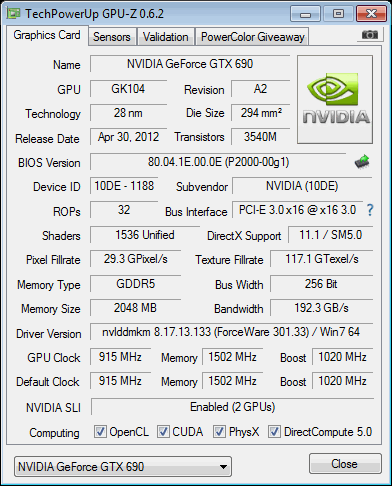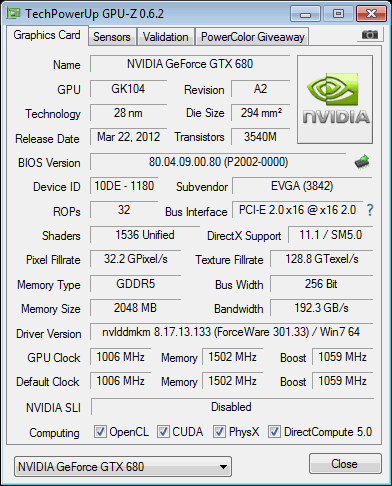GeForce GTX 690 Review: Testing Nvidia's Sexiest Graphics Card
We already know that Nvidia's GeForce GTX 690 sports two GK104s and is priced at $1000. But hardware like this is fun to read about. Oh, you actually want to buy one? Expect performance just shy of two GTX 680s in SLI, and good luck tracking one down!
PCI Express 3.0 And What Of GK110?
PCI Express 3.0 Representing
There’s a story behind Nvidia’s support for third-gen PCI Express and Intel’s X79 Express platform. But it requires a little bit of history.
Way back when I first previewed Sandy Bridge-E (check out Intel Core i7-3960X (Sandy Bridge-E) And X79 Platform Preview for that little piece of history), everyone I talked to insisted that the processor’s PCIe controller wasn’t going to be validated at 8 GT/s data rates. It'd be a PCIe 2.0 part. Then, suddenly the story changed and it was called 8 GT/s-capable (though mention of the standard itself was left out).
When AMD launched its Radeon HD 7000-series cards, we were able to demonstrate them operating at PCI Express 3.0 signaling speeds. Then, Nvidia launched its GeForce GTX 680—with a press driver that was limited to 5 GT/s. The company sent us a second version to show that PCI Express 3.0 was working, and assured us that it’d operate at 8 GT/s on Ivy Bridge-based platforms (which we’ve since confirmed).
Why not just ship it like that? There was a reason, we are digging deeper, but aren’t yet ready to discuss the results.
Let’s put the puzzle pieces together, though.
- X79 and Sandy Bridge-E were originally going to operate at second-gen signaling rates.
- GeForce GTX 680, a card that scales really well in SLI, operates at 5 GT/s data rates attached to Sandy Bridge-E processors and 8 GT/s in Ivy Bridge-based platforms.
- GeForce GTX 690 offers 8 GT/s signaling in both Sandy Bridge-E and Ivy Bridge-based platforms.
The issue doesn’t appear to be related to GK104, Nvidia’s card, or its driver. Rather, it’d seem to relate back to our original report that Sandy Bridge-E was not fully validated for PCI Express 3.0.
Get Tom's Hardware's best news and in-depth reviews, straight to your inbox.


Is This It For Affluent Gamers In 2012?
I saw a lot of comments from folks who read GeForce GTX 680 2 GB Review: Kepler Sends Tahiti On Vacation and decided they wanted to wait for Nvidia to launch a desktop-oriented card based on a more complex graphics processor—if only because they were unwilling to pay $500 for the company’s next-gen “Hunter” (if you don’t know what I’m talking about, check out the first page of my GeForce GTX 680 review).
On behalf of those folks, I plied Nvidia for more information about a proper “Tank” in the GeForce GTX 600-series. Although the company’s representatives were deliberately vague about the existence of another GPU, they clearly indicated that GeForce GTX 690 wouldn’t be eclipsed any time soon. Personally, I’d be surprised to see anything based on a higher-end GPU before Q4.
Even then, there’s no guarantee that a tank-class card would outperform two GK104s (GF104 had little trouble destroying GF100 in Amazing SLI Scaling: Do Two GeForce GTX 460s Beat One GTX 480?, after all). The more likely outcome would be a better-balanced GPU able to game and handle compute-oriented tasks.
Current page: PCI Express 3.0 And What Of GK110?
Prev Page Overclocking And Tessellation Performance Next Page Test Setup And Benchmarks-
robwright I wonder, given the price of the 690, just how limited the quanitities will be. Which brings up another question, one that Nvidia (and AMD as well) would probably be reluctant to answer: are they making and shipping fewer of the top-shelf Halo cards today than they did 5 or six years ago?Reply -
rebel1280 ....... Lamborghini’s Reventón ...... +infinity for mentioning that work of art T_T didn't even read the article until after I got my fix for the Lamborghini’s Reventón on the net haha. That car may be the only proof left to us of the old gods, in particular Mercury (god of transport) lolReply -
lahawzel 680s are already nearly nonexistent, so I expect these 690s to be just as mythical and hard-to-find as the Radeon 6990.Reply -
phamhlam LaHawzel680s are already nearly nonexistent, so I expect these 690s to be just as mythical and hard-to-find as the Radeon 6990.Reply
6990 aren't that hard to find. Back in January before the 7000 series came out, you could easily pick one or two up. I am pretty sure in 6 month, the 690 will be easy to grab. -
frombehind I wonder if someone will come out with a version that has a stock water-cooler built in? Then it really would the card to get ^^Reply
